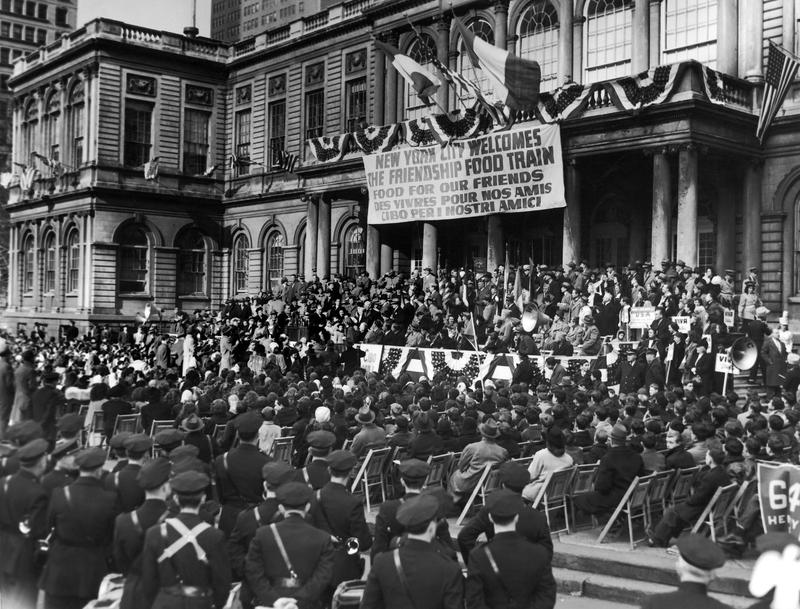Friendship Train Attempts to Humanize Postwar Effort

These two 1947 broadcasts mark the start and finish of the Friendship Food Train's U.S. journey, a project conceived to help the people of Europe get through the winter.
Though largely a symbolic effort in comparison to the Marshall Plan, the Friendship Food Train put a human face on the United States' effort to aid France and Italy after the devastation of World War II. Cities and towns contributed what they could at stops across the country. Reports from the train were broadcast to Europe, providing potent propaganda in what was soon to become a battle for the continent's political allegiance.
In the first recording -- a brief announcement -- the mayor of New York, William O'Dwyer, explains that the train has just left Los Angeles, bound for the East Coast, and will stop along the way to pick up donations of food. He specifies which foods will survive the eventual shipment overseas: flour, macaroni, spaghetti, sugar, dried beans and peas, and cans of evaporated milk.
The next recording is of a ceremony in front of City Hall celebrating the train's arrival 11 days later. This is a more elaborate affair featuring the ubiquitous Grover Whalen introducing O'Dwyer. The audience seems to consist mainly of schoolchildren forced to sit through speeches by, in addition to the mayor, U.N. Ambassador Warren Austin, the well-known columnist Drew Pearson, the French consul-general, the wife of the Italian ambassador, and the Italian consul-general. Many calls for peace, universal brotherhood, and the rebuilding of Europe are made. (One would never know, from listening to this event, that the Italians had fought against the United States in the recently concluded war.) The proceedings are somewhat enlivened by the brass bands of the Police, Fire, and Sanitation departments playing the national anthems of the respective countries.
The Friendship Food Train was the brainchild of Pearson (1897-1969), who first suggested the idea in his column, "Washington Merry-Go-Round." Pearson, as the website thefriendshiptrain1947.org explains:
…loathed the thought of Communism in Europe. He believed that the United States could surpass the Communists in sending food to the desperate, hungry Europeans. Announcing his idea of sending food across the Atlantic in his broadcasts and columns on October 11, 1947, Pearson asked Americans to donate food from their homes, kitchens, gardens, and fields. Five weeks after Pearson's announcement, in November 7, 1947, the Friendship Train began its unprecedented odyssey across our country. Beginning in Los Angeles, where there was a terrific send-off, and ending in New York City with another extraordinary celebration. Although the train traveled through only 11 states, every state contributed by sending its boxcars or trains to meet the Friendship Train at a junction or by sending trucks to the train.
As Pearson emphasizes in his speech, this entire project was organized and funded by private interests. There was no government involvement whatsoever. On the West Coast, Jack Warner mobilized the film community to help. The railroads offered free use of their cars and tracks. Various unions contributed their labor. Pearson's call, whether motivated by ideological or philanthropic aims, certainly struck a chord throughout the country, even in communities without any obvious ties to the countries in need. In Iowa, the Ames Daily Tribune announced:
From all indications the Friendship Train goal of $10,000 or its equivalent in food to be shipped from here will be surpassed. … This amount includes $1,673.76 collected by the women of Ames in a house-to-house canvas. A philanthropic individual, Siegfried Olson, farmer, plans to sell a team of horses at the Ames sales barn Wednesday, with the proceeds going to the Friendship Train. …Sales of the "Westend [sic] News," a publication put out by a group of neighborhood children in Ames regularly, sold for 2 cents a copy instead of a penny this week. The children explained the increase was to benefit the Friendship Train.
Pearson's involvement did not end with the ceremony presented here. He accompanied the shipments of food to both France and Italy, presiding over its distribution, following up on his idea of mixing foreign aid and diplomacy, ensuring by means of labels on all items as well as banners unfurled at every stop that the people of Europe knew where the largesse was coming from.
The people of France reciprocated in 1949 by sending the Merci Train, which retraced the path of the Friendship Train, distributing gifts of thanks from French citizens, including, the Kansas Historical Society reports:
…pottery, porcelain, crystal, woodwork, church bells, bonnets, costumes, historical documents, musical records, books, and letters written by schoolchildren. French people contributed their own possessions in many instances, sometimes attaching a personal note.
Many of these gifts, fine examples of local craft, are now on display at museums across the country.
Audio courtesy of the NYC Municipal Archives WNYC Collection.
